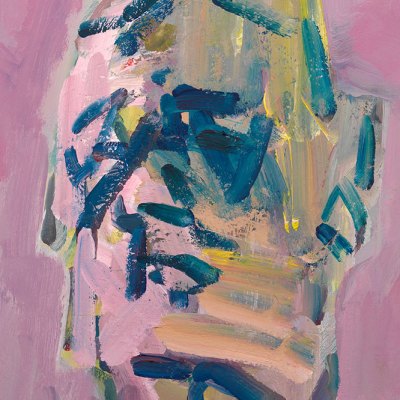Frank Auerbach, best known for his impasto renderings of London and his atmospheric portraits and self-portraits, has died at the age of 93. Born in Berlin in 1931, Auerbach arrived in England as a refugee from Nazi Germany when he was seven years old; he never again saw his parents, who were murdered in Auschwitz in 1942. At the age of 16 he decided to become a painter and enrolled at St Martin’s School of Art in 1948 and then the Royal College of Art, taking additional classes at the Borough Polytechnic. It was here that he came under the influence of the artist David Bomberg, whose decisive, linear brushwork had an important effect on his own work. In a rare interview with the BBC, broadcast in January 2024, Auerbach spoke of Bomberg as an inspirational teacher: ‘He talked to people as though they were trying to make masterpieces on a National Gallery level.’ In 1954 Auerbach took up residence in a studio in Mornington Crescent, north London, where he would live and work every day for the rest of his life. He began to make a name for himself in the 1950s – alongside his near contemporaries Lucian Freud and Leon Kossoff – with his semi-abstract depictions of London, developing a highly physical style of mark-making style. He used a similarly vigorous technique in his portrait painting, and around the same time began rendering large-scale portrait heads in ghostly, shadowy charcoal. Auerbach had his first retrospective in 1978, at the Hayward Gallery in London; eight years later he won the Golden Lion at the Venice Biennale. He worked every day, all his life, painting a series of distinctive charcoal self-portraits during the Covid lockdowns. Auerbach once said that he strove for his paintings to be ‘stonking’; it is generally agreed that he succeeded.
Italian police have uncovered a network of art forgers spanning western Europe, and have seized some 2,100 fake works with a market value of around €200m. The Guardian reports that Italian authorities began investigating the network last year after police took possession of 200 forgeries, including a drawing claimed to be by Amedeo Modigliani, from the collection of a businessman in Pisa. The police discovered six workshops, three of which were in Italy, that specialised in forging works purported to be by Warhol and Banksy. The forgers struck deals with Italian auction houses to sell the works and organised two exhibitions, in Mestre and Cortona, including a published catalogue of work ‘by Banksy’. Other artists whose work was forged included Monet, Dalí, Van Gogh, Chagall and Henry Moore. Thirty-eight people have been placed under investigation in Italy, Spain, France and Belgium. Teresa Angela Camelio, Pisa’s chief prosecutor, said that the network of forgers was ‘interconnected with compliant auction houses’.
The Manhattan district attorney has announced the return of 1,440 antiquities, worth some $10m, to India. The objects were recovered in the course of investigations into trafficking networks that included disgraced dealers Subhash Kapoor and Nancy Wiener. Kapoor has spent the last 13 years in an Indian prison for antiquities trafficking. Among the ancient objects that have now been repatriated are a sandstone sculpture of a celestial dancer, which was looted from a temple in Madhya Pradesh in the 1980s, and a green-grey schist carving of a goddess, which was stolen from a village in Rajasthan in the 1960s. Both of these items entered the collection of the Metropolitan Museum of Art in New York in 1993 and remained there until they were seized by the Antiquities Trafficking Unit, a branch of the DA’s office, in 2023 and 2022 respectively.
The British Museum has received a gift of Chinese ceramics worth some £1bn from the trustees of the Sir Percival David Foundation, established by the British businessman and collector Percival David. The 1,700 ceramics, which date from the third to the 20th century, comprise a collection that has been on long-term loan to the museum since 2009. It is the largest donation the British Museum has ever received, and brings the institution’s total collection of Chinese ceramics to around 10,000 items, making it the largest group of such items outside the Chinese-speaking world. Highlights include the elegant blue and white ‘David vases’ (1351) and a 14th-century ‘chicken cup’ used by the Chenghua Emperor.
Sotheby’s has paid more than $6m to settle a tax evasion case in New York, reports the Art Newspaper. The state’s attorney general brought the case in 2020, alleging that the auction house had helped collectors avoid paying the sales taxes levied separately by the city and the state of New York by giving collectors resale certificates – documents that would exempt from taxability any art purchases made between 2010 and 2020. ‘No one should be allowed to cheat the system and escape paying the taxes they owe,’ said attorney general Letitia James in a statement. ‘Sotheby’s intentionally broke the law to help its clients dodge millions of dollars in taxes, and now they are going to pay for it.’



